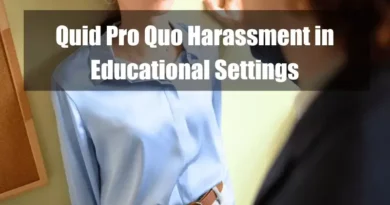How to Report Quid Pro Quo Harassment at Work
Takeaways
| Key Points |
|---|
| When reporting quid pro quo harassment at work, the first step is typically internal reporting by contacting Human Resources (HR) or a designated officer responsible for handling complaints, ensuring adherence to company policies and proper documentation of the incidents, including dates, times, and communications. |
| If internal reporting fails or is unsafe, external options include filing a complaint with the Equal Employment Opportunity Commission (EEOC) or state-level fair employment practices agencies, both of which have specific filing deadlines and procedures. |
| Legal considerations, such as protections against retaliation, emphasize the importance of documenting adverse actions and seeking legal advice from an employment lawyer to navigate complex cases, gather evidence, and explore potential settlements. |
| After filing a complaint, it is essential to monitor the employer’s response, follow up on the investigation’s progress, and escalate the issue if the response is inadequate, potentially leading to external agency involvement or legal proceedings. |
| Throughout the process, maintaining confidentiality, securing evidence, and understanding available legal protections help ensure a thorough and fair resolution to the harassment complaint. |
Introduction
Quid pro quo harassment is a pervasive workplace issue affecting employees across various industries. This form of harassment occurs when someone in a position of power demands sexual favors in exchange for job benefits, such as promotions, raises, or even continued employment.
Recognizing and reporting quid pro quo harassment is crucial to maintaining a safe and respectful work environment. Knowing how to navigate the reporting process empowers victims to seek justice and contributes to preventing future incidents.
Understanding Reporting Channels

Internal Reporting
Reporting to HR or a Designated Officer
When faced with quid pro quo harassment, the first step typically involves reporting the incident to your company’s Human Resources (HR) department or a designated officer responsible for handling such complaints. HR is usually tasked with maintaining workplace safety and can initiate an internal investigation. It’s essential to understand your company’s specific reporting procedures, which may be outlined in your employee handbook or company policy documents.
In some cases, the designated officer might be part of a compliance or ethics team, especially in larger organizations.
Utilizing Internal Complaint Procedures
Companies often have formal procedures for handling harassment complaints. These procedures might include submitting a detailed written complaint, which will trigger an internal investigation. It is important to follow these procedures carefully to ensure your complaint is processed correctly.
Documentation and timely reporting are crucial in this process, as they help establish a clear timeline of events and provide a foundation for subsequent actions.
External Reporting
Filing a Complaint with the Equal Employment Opportunity Commission (EEOC)
External reporting becomes necessary if internal reporting does not resolve the issue or the situation is too severe to handle internally. The EEOC is the primary federal agency in the United States responsible for enforcing laws against workplace discrimination, including sexual harassment.
Filing a complaint with the EEOC involves submitting a “charge of discrimination,” which officially initiates the investigation process. The EEOC may offer mediation as a first step, but the case could proceed to a formal investigation or litigation if that fails. It’s important to adhere to filing deadlines; typically, you must file a charge within 180 days of the incident.
Reporting to State-Level Fair Employment Practices Agencies
In addition to the EEOC, many states have fair employment practices agencies that handle harassment and discrimination cases. These agencies may have different procedures and requirements from the EEOC, so you must familiarize yourself with your state’s specific regulations. Some states offer extended filing deadlines or additional protections to benefit your case.
Legal Advice and Representation
Navigating the reporting process can be complex, especially when dealing with external agencies. Seeking legal advice from an employment lawyer is highly recommended. A lawyer can guide you through the process, help you understand your rights, and represent you in legal proceedings.
They can also assist in gathering evidence, filing the necessary paperwork, and negotiating settlements if necessary.
Documenting the Incident

What to Document
Details of the Harassment (Dates, Times, Locations, etc.)
Accurate documentation is key to building a strong case when reporting quid pro quo harassment. You should record all details related to the harassment, including the dates, times, and locations of each incident. This documentation is critical evidence supporting your claim during an investigation.
Any Communications with the Harasser (Emails, Messages)
If the harassment involved any form of communication, such as emails, text messages, or voice mails, it is crucial to preserve these as evidence. These communications can directly demonstrate the harasser’s intentions and actions, providing concrete proof to support your allegations.
Witnesses and Other Relevant Evidence
If there were any witnesses to the harassment or individuals who can corroborate your story, make a note of their names and contact information. Witness statements can strengthen your case by providing additional perspectives and confirming your account of the events. Any other relevant evidence, such as physical items or documents related to the harassment, should also be collected and preserved.
How to Safely Store Documentation
Importance of Keeping Records Secure and Confidential
Maintaining the security and confidentiality of your documentation is vital. You should store physical documents securely, such as in a locked drawer or safe. Use password-protected files or encrypted storage solutions to prevent unauthorized access to digital records. Keeping your evidence secure ensures it remains intact and can be presented in its original form during any investigations or legal proceedings.
Filing an Internal Complaint

Steps to Take
Contacting HR or the Appropriate Department
Once you’ve gathered your documentation, the next step is to file an internal complaint. Start by contacting your HR department or the appropriate person handling harassment complaints. It is important to do this promptly, as delays can weaken your case and potentially lead to further harm.
Submitting a Written Complaint
Your complaint should be submitted in writing, detailing the harassment you experienced. Include all relevant information, such as the dates, times, and locations of the incidents, as well as any evidence you’ve gathered. Be clear and concise in your description to avoid any misunderstandings or misinterpretations.
Requesting a Formal Investigation
In your written complaint, consider explicitly requesting a formal investigation into the matter, as this may prompt the employer to take more immediate and thorough action. A formal investigation typically involves interviewing the parties involved, reviewing evidence, and making determinations based on the findings.
What to Expect
The Employer’s Responsibility in Investigating
Once your complaint is filed, the employer is responsible for conducting a thorough and impartial investigation. This process should be handled with confidentiality and fairness, ensuring the complainant and the accused are treated appropriately. The employer is expected to take corrective action if the investigation finds evidence of harassment.
Possible Outcomes and Resolutions
Depending on the findings, the investigation may result in several possible outcomes. These can include disciplinary action against the harasser, such as termination or suspension, mediation between the parties, or changes in company policies to prevent future incidents. It’s important to stay informed about the investigation’s progress and any actions the employer takes.
Filing an External Complaint

When to Consider External Reporting
If Internal Reporting Fails or Is Unsafe
If the internal reporting process does not resolve the issue, or if you feel that reporting internally is unsafe, it may be necessary to escalate the matter to an external agency. External reporting is often the best option if the harassment involves senior management or if there is a risk of retaliation.
Retaliation Concerns
Retaliation is a significant concern when reporting harassment, especially if the harasser holds a position of power. Federal and state laws protect employees from retaliation, and any such actions can lead to additional legal claims. If you experience retaliation after reporting harassment, document it and report it immediately to the appropriate authorities.
EEOC Filing Process
Steps to File with the EEOC
Filing a complaint with the EEOC involves several steps. First, you must file a charge of discrimination, which formally notifies the EEOC of your complaint. The EEOC may offer mediation as an initial step to resolve the issue. If mediation fails, the EEOC will investigate the complaint, which may involve interviews, document reviews, and other investigative methods.
Deadlines and Important Timelines
It’s crucial to adhere to the EEOC’s filing deadlines. Generally, you must file a charge within 180 days of the incident. However, this period may be extended to 300 days if state laws also apply. Missing these deadlines can result in the dismissal of your complaint, so it’s important to act promptly.
State Agency Filing Process
Differences in State Procedures
State fair employment practices agencies may have different procedures and requirements from the EEOC.
Some states offer additional protections or extended filing deadlines, which can be advantageous in certain cases. Researching your state’s specific procedures is important to ensure your complaint is properly filed.
Specific Forms and Documentation Required
When filing with a state agency, you may be required to submit specific forms or documentation. These requirements vary by state, so gathering all necessary information and completing the required paperwork accurately is important.
Providing thorough and accurate documentation can help expedite the investigation process.
Legal Considerations

Retaliation Protections
Understanding Legal Protections Against Retaliation
Federal and state laws provide protections against retaliation for employees who report harassment. You have the right to file a separate complaint if you experience retaliation, such as demotion, termination, or other adverse actions.
Retaliation claims are taken seriously, and employers may face legal consequences for such actions.
How to Report Retaliation if It Occurs
If you experience retaliation, document the incidents thoroughly and report them to the appropriate authorities, whether internally or externally. Retaliation can lead to additional legal claims, so it is important to address it promptly and seek legal advice if necessary.
Consulting with an Employment Lawyer
When to Seek Legal Advice
Consulting with an employment lawyer is advisable if you are unsure about any aspect of the reporting process or if the harassment involves serious or complex issues. A lawyer can guide you, help you understand your rights, and represent you in legal proceedings.
Employment lawyers can also assist in negotiating settlements or taking legal action if necessary.
How a Lawyer Can Assist in the Reporting Process
A lawyer can play a critical role in reporting by helping you gather evidence, file complaints, and navigate legal complexities. They can also advise you on the best course of action, whether that involves mediation, litigation, or other forms of resolution.
After the Report

Monitoring Employer Response
Ensuring the Employer Takes Appropriate Action
After filing your report, monitoring your employer’s response is essential to ensure they take the necessary steps to address the complaint. Employers have a legal and ethical obligation to conduct a thorough and impartial investigation of harassment claims. This may involve interviewing the parties, gathering evidence, and determining the appropriate action.
It’s important to maintain communication with HR or the designated officer handling your case to stay informed about the progress of the investigation. If your employer fails to act or the investigation is not conducted properly, it may be necessary to escalate the issue further.
Following Up on the Investigation’s Progress
During the investigation, keep track of all communications with your employer. Regular follow-ups are important to ensure that the investigation is moving forward. If the process is taking longer than expected, politely inquire about the status of the investigation and the expected timeline for a resolution.
Being proactive demonstrates your commitment to resolving the issue and ensures your complaint is not overlooked.
What to Do if the Response is Inadequate
Additional Steps to Take
If you find your employer’s response to the complaint inadequate or if the situation worsens, additional steps may be necessary. This could include filing a complaint with an external agency like the EEOC or your state’s Fair Employment Practices agency.
You might also consider consulting with an employment lawyer to explore your legal options, including potential litigation or settlement negotiations.
Escalating the Issue to Higher Authorities
In cases where the internal reporting process fails to resolve the issue, or if you believe your employer is not taking your complaint seriously, escalating the matter to higher authorities is a viable option.
In extreme cases, this could involve contacting regulatory bodies or legal representatives. While this is generally a last resort, it may be necessary to ensure that your rights are protected and that the harasser is held accountable.
Support and Resources
Employee Assistance Programs (EAPs)
Accessing Counseling and Support Services
Many employers offer Employee Assistance Programs (EAPs) to provide confidential counseling and support services for employees dealing with workplace harassment. EAPs typically offer mental health support and may provide general guidance on the reporting process. While legal advice is not always provided directly through EAPs, employees can often receive referrals to external legal resources.
Accessing these services can help manage the emotional and psychological toll of harassment and offer crucial support when taking steps to report or resolve workplace issues.
External Support Services
Non-Profits and Organizations Offering Help
Numerous non-profit organizations specialize in helping victims of workplace harassment by offering legal advice, counseling, and other support during the reporting process. Notable organizations include the National Women’s Law Center, Equal Rights Advocates, and Workplace Fairness, which offer resources and advocacy to help individuals understand their rights and take appropriate action against harassment.
Community Resources for Victims of Harassment
Beyond non-profits, community resources such as local advocacy groups, legal aid societies, and community health centers can provide support services, including legal representation, counseling, and crisis intervention. These services are often offered at low or no cost, making them accessible to individuals who may not have other forms of support.
Conclusion
Reporting quid pro quo harassment is a critical step in protecting yourself and others from further harm in the workplace. By understanding the reporting channels, documenting the incident, and following through with internal and external complaints, you can take control of the situation and seek justice.
The process can be challenging, but with the proper support and resources, it is possible to hold harassers accountable and create a safer, more respectful work environment for everyone.
FAQ
What constitutes quid pro quo harassment under employment law?
Quid pro quo harassment occurs when a person in authority demands sexual favors from an employee or job applicant in exchange for employment benefits, such as promotions, salary increases, or continued employment. This form of harassment is prohibited under Title VII of the Civil Rights Act of 1964.
How does the “respondeat superior” legal principle apply to quid pro quo harassment cases?
Under the doctrine of respondeat superior, an employer can be held liable for the actions of its employees if those actions occur within the scope of employment. In quid pro quo harassment cases, if a supervisor engages in harassment, the employer may be held responsible for the supervisor’s conduct.
What is the significance of “tangible employment action” in proving quid pro quo harassment?
A tangible employment action refers to a significant change in employment status or benefits, such as hiring, firing, promotion, demotion, or reassignment. In quid pro quo harassment cases, the harasser’s demands are typically linked to such tangible employment actions, making it a critical element in establishing the claim.
How does “constructive discharge” relate to quid pro quo harassment?
Constructive discharge occurs when an employee resigns due to intolerable working conditions created by the employer or supervisor. If these conditions result from quid pro quo harassment, the resignation may be considered a constructive discharge, potentially leading to employer liability.
What role does “unwelcome conduct” play in establishing a quid pro quo harassment claim?
For a quid pro quo harassment claim to be valid, the sexual advances or requests must be unwelcome. The employee’s perception of the conduct as unwelcome is essential in proving that harassment occurred.
How does the “statute of limitations” affect the reporting of quid pro quo harassment?
The statute of limitations sets the time frame within which a harassment claim must be filed. Under federal law, an individual has 180 days from the date of the alleged harassment to file a charge with the Equal Employment Opportunity Commission (EEOC). This period may be extended to 300 days if a state or local agency enforces a law prohibiting employment discrimination on the same basis.
What is the “burden of proof” in quid pro quo harassment cases?
The burden of proof lies with the employee (plaintiff), who must demonstrate that the harassment occurred. This includes proving that the conduct was unwelcome, linked to a tangible employment action and that there was a causal connection between the rejection of the advances and the adverse employment decision.
How does “vicarious liability” impact employers in quid pro quo harassment cases?
Employers can be held vicariously liable for quid pro quo harassment committed by supervisors with immediate or successively higher authority over the employee. This means the employer is responsible for the supervisor’s actions, regardless of whether the employer was aware of the harassment.
What is the importance of “mitigation of damages” in these cases?
Mitigation of damages refers to the obligation of the harassed employee to take reasonable steps to reduce the harm suffered, such as seeking alternative employment if terminated. Failure to mitigate damages can affect the compensation awarded in a successful claim.
How does “retaliation” relate to reporting quid pro quo harassment?
Retaliation occurs when an employer takes adverse action against an employee for reporting harassment or participating in an investigation. Retaliation is illegal, and employees are protected under Title VII from such actions.
What constitutes “constructive knowledge” of harassment by an employer?
Constructive knowledge means that an employer should have known about the harassment, even if they were not directly informed. Employers are expected to exercise reasonable care in preventing and addressing harassment in the workplace.
How does the “Faragher-Ellerth defense” apply to employer liability in harassment cases?
The Faragher-Ellerth defense allows employers to avoid liability for supervisor harassment if they can prove that they exercised reasonable care to prevent and promptly correct any harassing behavior and that the employee unreasonably failed to take advantage of preventive or corrective opportunities provided.
What is the role of a “hostile work environment” concerning quid pro quo harassment?
While quid pro quo harassment involves explicit exchanges of sexual favors for job benefits, a hostile work environment refers to unwelcome conduct that is severe or pervasive enough to create an intimidating, hostile, or offensive work environment. Both are forms of sexual harassment but differ in their manifestations.
How does “preponderance of the evidence” apply in proving quid pro quo harassment?
In civil cases, including quid pro quo harassment claims, the standard of proof is the preponderance of the evidence. This means the plaintiff must show that it is more likely than not that the harassment occurred.
What are the potential “remedies” available to victims of quid pro quo harassment?
Victims may be entitled to remedies such as reinstatement, back pay, compensatory damages for emotional distress, punitive damages, and attorney’s fees. The specific remedies depend on the circumstances of the case and the applicable laws.









